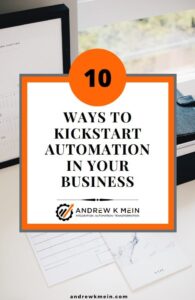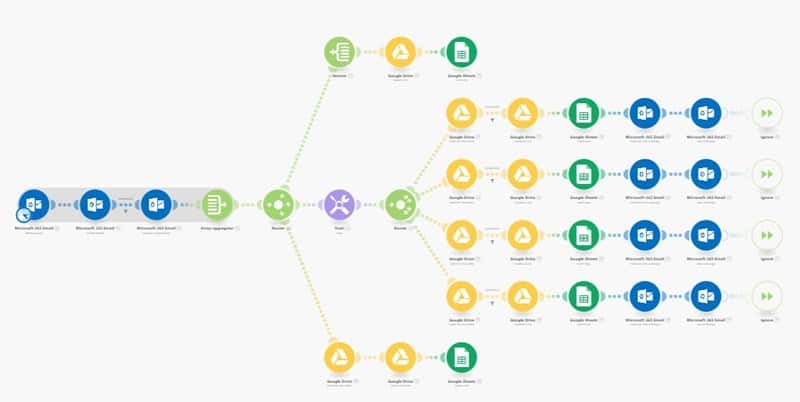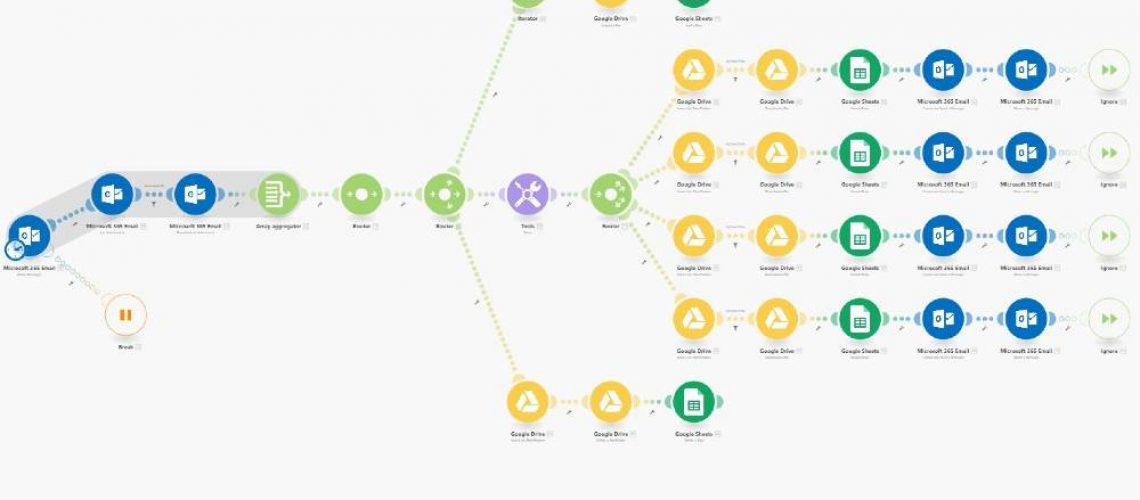What is business automation?
Business process automation is the use of technology to perform processes automatically in order to free up time in a business, by reducing the need to manually complete scheduled or repetitive tasks.
64% of
, according to a recent Zapier report, but there are many businesses where it is not used at all or full potential.knowledge workers
use some kind of business automation software
Marketing automation is perhaps where most people first come across automation in business, but as you will see there are many other places it can and I believe should be implemented.
In this post I provide 11 business automation tips to help you get started and an additional 10 tips suggesting processes that you could consider automating in your own business
FREE UP TIME TODAY
- Access 10 Simple Automations you can use in your business today.
- Discover how to recover the time lost doing repetitive, mundane tasks…
- Spend time growing your business rather than just working in it.

Table of Contents
How do I automate my business?
Success starts with preparation:
-
Identify the repetitive work.
The first place businesses should start is to list the activities they currently do on a regular basis. Note down how often each task is done and how long it generally takes. Try to record all the the administrative type work you currently do as manual processes and that take up your time. A good way to think about whether something should be automated is by asking yourself these three questions.

- Is this something I do frequently or on a schedule?
- Does this involve moving data from one online system to another?
- Does this stop me doing the the things I really want to be doing?
Remember that even a weekly 30 minute task could save you 26 hours in a year
-
Define the task.
If you don’t know how to do a task manually, you won’t be able to automate it. It seems fairly obvious to say that, but it’s surprising how many people come unstuck here. Write down the process, step by step the next time you do the task manually. Record as much as you can about each step. Think about how you would write for someone new to take over. Having these steps written down is will make a huge difference to the creation and maintenance of the workflow. -
Don’t make it difficult.
You don’t always need additional software to automate. When considering how to build your automation always look for opportunities within the software you already use. eg set up rules and forwarders for managing your email in Outlook, or use the automatic reminders feature in your accounting software ie Xero. If you haven’t checked all the features available recently, it might be a good time to do so now. -
Identify the right software to create the workflow.
If your software doesn’t help directly, there are many automation software platforms available which will help businesses integrate and automate their systems. The one many people start with is Zapier which supports a huge range of integrations and is very easy to learn. Others like integromat are more complicated to learn, but offer greater functionality. To find out more about the 6 top automation tools have a look at this recent blog post.
Prioritising your automations
-
Calculate the ROI.
Before you dive into the actual build process it’s important to think about the time/cost of creating your automation versus the time/cost savings to be made. Use this as a guide to help you prioritise the automations you want to implement. -
Begin with the simpler tasks.
You may look at the larger tasks and think they should be the ones you attempt automating first because they take up most of your time. While that may be true; if you are just starting to automate, you are more likely to hit issues when trying to create a complex automations. It can be extremely frustrating if that happens and you could be put off continuing. That’s why I suggest that if you are creating the automations yourself, it is better to start with the simpler one in order to see the benefit quickly and to learn at a steadier pace. If you decide you don’t want to do the automations yourself then an automation specialist (see 11) will help you identify the most appropriate ones
Building your business automation
-
Filter unnecessary data.
Use the steps you identified in step 3 as the building blocks for your automation. When creating the trigger do your best to filter out any unnecessary trigger to save wasting operations. eg when watching for emails, you could filter by subject or sender to prevent triggers for every single email. If the trigger step does not allow filtering directly add a filter as the second step which will prevent those unnecessary triggers from being processed through the rest of the workflow.
-
Test, test and test again.
Once you have created your automations, it is vital that you test them. To be confident that the task will run correctly on, time every time, it is vital to test the workflow correctly to make sure it works. Try to think of all the possible things that could arise such as date format differences, double barrelled names, filename format not as expected. By doing this you can put in checks along the way to pick up those differences and minimise the issues.

Learn How To Use Zapier

Monitor and improve
-
Set up an error notification.
No matter how much testing you do there will always be something that could go wrong. One of the cloud systems you use could have an issue so the automation cannot connect, the format of data supplied from the trigger event could be slightly different to what you anticipated. In these situations you can set up an email alert to advise you so that you can correct the error and amend the automation steps if necessary. -
Continually Improve.
Now that your business automation is working you should look for opportunities to improve the processes. Can you think of any additional things you could do to make that business processes even better. Perhaps you could add a notification to an automation that moves a project task, or maybe you could update a spreadsheet every time your run an automation which takes email attachments and adds them to Dropbox. The possibilities are endless, but the more you automate the more time you save.
Do I need to do it all myself
-
Consider using an automation specialist.

As mentioned in tip 6; perhaps you don’t want to have to learn to use the automation tools. Maybe you’re too busy or just don’t want to have to learn how to use the tools available.
An Automation Specialist can help you to assess, design and implement your requirements for you. Although there is a cost; the work will most likely be done more quickly; so you can begin see the benefits sooner.
Remember to look at the value of the service and not just the cost. Ask yourself what difference will this make to me and my team? it may be a cost saving, but it may just as likely be a saving in time, a reduction in human errors or gaining much needed peace of mind, just knowing that the you no longer have to worry about those activities.
What can I automate in my business?
Below are just a few of the things you could consider as possible automation options. The list is by no means exhaustive, but should help to give you some ideas to get your started.
-
Client Onboarding.
Whatever service you provide there are likely to be tasks that you repeat when you take on a new client. First impressions are so important, so make your client feel welcome with a welcome explaining important aspects of their service. You could also send a questionnaire to gather the information you need to be able to support them most effectively. For an even more personal touch you could send a hand written welcome note to new clients by linking your CRM with a service like Handwrytten. -
Customer service and relationship management.
As mentioned above first impressions count, but even more important is customer service and the ongoing relationship, There are benefits to be had here also. Automate the gathering of data or reports so that it is emailed to you and your client a couple of days before your quarterly client meeting. Not only does it give the client and you time to review the information, it will act as a subtle reminder that you have an important customer service meeting scheduled.
Website reporting.
Knowing how your website is preforming, who is visiting and from where is really important. It helps you ensure that your marketing campaigns are working properly and generating leads. Why not automate the gathering of Google analytics reports and have them sent to your team’s slack channel or group email address once a week.

-
Proposal preparation.
Preparing proposals takes time, gathering the information, formatting the document, adding the clients details and getting approval etc, but by linking tools like Pandadoc with your CRM or Accounting software you can generate the documents quickly and easily, get approval from the client and pass the necessary details to the your accounting software for invoicing when the time comes. -
Project Management.
Link your CRM and your Project management tools to ensure client data is kept in sync. Automatically move tasks between stages as they are completed or notify the relevant team by email when a new project task is added to their stream. -
Email Marketing.
Social Media Today reports that 75% of marketers said they used at least one marketing automation tool. Connecting your email marketing software to your CRM is one of the easiest and most common automations. This means that new leads are added to the CRM automatically or if a client changes their contact details in the CRM the email address is updated in your marketing software. -
Social Media.
Social media understandably plays a huge part in business marketing and the generation of new leads. Simplify your social media campaigns, by automatically sharing new blog posts to your social media platform. You could also automatically create social media posts with details of your latest newsletter or service to your all your social media accounts in one go. -
Invoicing.
With automation you can speed up the invoicing process. Connect your project management tools to your accounting system and automatically generate an invoice when a project or stage is completed. Not only does this save you time, but it also means you get paid as quickly as possible after the work is complete. -
New staff inductions.
Similar to client onboarding there are processes that you most likely repeat when you take on new staff. You could generate a set of induction documents customised for the new employees and have them sent to them by email over a period of days. By automating this both you and the employees benefit from the ease of the induction process. -
Team Meetings.
In most businesses regular team regular meetings are usually scheduled weeks or months in advance, so it’s easy to forget about them and their purpose. Using your cloud storage and emails systems it is possible to automate the distribution of the agenda and any associated information. All you need to do is specify a storage folder where the information will be stored and upload the relevant documents when you need it for the next meeting. Then the automation software checks that area a few days before the meeting and automatically adds the contents to an email reminder sent to the attendees.
Conclusion
The reality is that we are all pressed for time. That is particularly so for small business owners who are possibly just at the stage where they need to take things up a level. That is when the realisation hits that we just cannot keep on going as we are. Automation is key to success in recovering some of that lost time and enabling us to focus on what we do best – running our businesses. If you haven’t yet taken the step towards automating in your business, there has never been a better time. Those that embrace automation will tell how it will transform your business, you’ll have more control over your time, you’ll be less stressed and all that leads to a more efficient and profitable business.
FREE UP TIME TODAY
- Access 10 Simple Automations you can use in your business today.
- Discover how to recover the time lost doing repetitive, mundane tasks…
- Spend time growing your business rather than just working in it.


